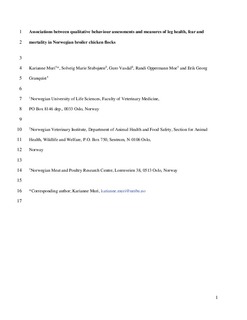| dc.description.abstract | Qualitative behavioural assessments (QBA) is an animal-based welfare measure that has been included in several on-farm welfare assessment protocols, including the Welfare Quality® (WQ) protocol for poultry. However, there is a scarcity of information about how it relates to other animal-based welfare indicators. The aim of this study was therefore to investigate the associations between QBA and selected animal-based welfare indicators commonly used for the assessment of broiler chicken welfare, i.e. lameness, foot pad dermatitis (FPD), fear of humans (touch test), and mortality. A total of 50 commercial broiler chicken farms were visited by one observer who conducted on-farm welfare assessments using the WQ protocol. Assessments were done close to the time of slaughter (between day 27 and 34). QBA was analysed using principal component analysis (PCA), revealing two main components, labelled arousal (PC1) and mood (PC2). The scores for the other welfare indicators were categorised into dichotomous (touch test) or ordinal scales (gait score, footpad dermatitis score and mortality) to deal with skewed distributions caused by homogenous data. To investigate the associations between QBA and the other welfare indicators, we ran logistic and ordinal logistic regression models with these welfare measures as outcomes, and the two components of QBA as the predictors. Significant negative associations were found between both components of QBA and the chickens’ fear of humans, as measured using the touch test. In other words, flocks with higher scores on both mood and arousal were less likely to have any chickens that were possible to touch by the assessor. A possible interpretation of these associations is that both QBA components may indicate greater liveliness in birds that did not accept to be touched by the observer. Flocks with a higher arousal score, as measured by the first component of QBA (PC1), were also less likely to be in a higher mortality category. For the other selected animal-based measures, there were no associations with QBA. We conclude that QBA needs thorough validation for the routine use in the assessment of broiler chicken welfare, but that the method may provide useful supplementary information in overall welfare assessments. This information may be particularly valuable in a production system, like the broiler industry, where management is highly standardised, sometimes resulting in little between-flock variation in other welfare measures. | nb_NO |
